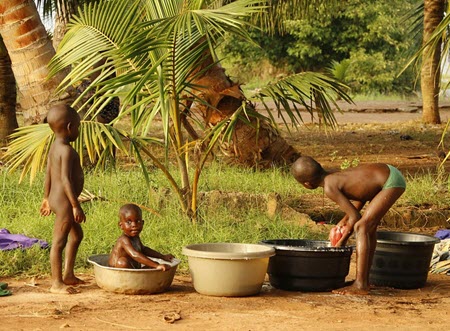Contents
During the colonial period and at independence, this country was known as Dehomey. Dahomey achieved full independence from France in 1960. In 1975, the name of the country was changed to Benin, after the Bight of Benin, the Atlantic bay that forms the country’s southern limit. Between 1975 and 1990, the country was a Marxist-Leninist state formally called the People’s Republic of Benin. In 1991, it became the multi-party Republic of Benin.
Where is Benin?
Benin is bordered by Togot to the west, Burkina Faso and Niger to the north, and Nigeria to the east. To the south is the Bight of Benin, which is a pat of the Gulf of Guinea.
Legislative capital vs “economic capital” of Benin
The capital of Benin is Porto-Novo, since that is where the national legislature sits.
However, the city of Cotonou is the seat of government and this is where you find most of the governmental buildings and headquarters of government departments.
Cotonou is also the most populated city in the country and is commonly referred to as the “economic capital” of Benin.
Economy of Benin
- Total GDP (PPP) $26.177 billion (2017 estimate)
- GDP (PPP) per capita $2,297 (2017 estimate)
- Nominal GDP $9.605 billion (2017 estimate)
- Nominal GDP per capita $842 (2017 estimate)
- HDI 0.515 (year 2018)
Compared to the rest of the world, this is low (163rd place out of 189 ranked countries)
Currency: West African CFA franc (XOF)
Overview
 Benin is highly dependant on agriculture and regional trade, and a significant part of the population is involved in subsistence farming.
Benin is highly dependant on agriculture and regional trade, and a significant part of the population is involved in subsistence farming.
Services contribute the largest part of GDP, especially those tied to trade, transportation, transit and tourism, where Benin benefits from its location by the ocean.
Cotton is an important cash crop, and accounts for roughly 40% of the GDP and around 80% of official export receipts.
The agricultural sector is the main driver of economic growth, although in recent years, rapid population growth has offset much of the growth in real output.
Inadequate electrical supply is hampering Benin’s economic growth. The government has taken steps to increase domestic power production, but this has yet not fixed the problem.
Labour force
Up to 75% of the formal workforce in Benin is represented by trade unions, but the situation is very different in the informal economy where a significant percentage of the workforce is occupied.
The International Trade Union Confederation (ITCU) has pointed out several serious and widespread issues within the informal economy, such as child labour, forced labour, and wage discrimination against women.
Debt relief
In 2005, it was announced that Benin would benefit from a G8 debt reduction.
The Millennium Challenge Account grant
Benin’s 307 million USD Millennium Challenge Account grant was signed in 2006. This grant is awarded by the Millennium Challenge Corporation (MCC), which is a bilateral United States foreign aid agency established by the U.S. Congress in 2004.
Projects aiming to improve the business climate by reforms to the land tenure system, the commercial justice system, and the financial sector are included in the stipulations for Benin’s grant.
Poverty
The percentage of Benin residents living under the poverty line increased from 36.2% in 2011 to 40.1% in 2015, according to data from the National Institute of Statistics and Economic Analysis in Benin.
Currency
Benin is a part of the EUMOA, a monetary union comprised of eight countries in Western Africa that all use the West African CFA franc (XOF) as their official currency. The XOF is pegged to the Euro.
Infrastructure
- There is a large seaport in Cotonou, and a new seaport is being built in an area between Cotonous and Porto Novo.
- The only international airport in the country is located in Cotonou.
- Two-lane asphalted roads connect Benin to Togo, Burkina Faso, Niger, and Nigeria.
- Mobile telephone service is available across the county through various operators.
- Benin has been connected to the Internet by way of satellite since 1998 and by the single submarine cable SAT-3/WASC since 2001. From an international perspective, the price of using internet is very high in Benin.Cotonou will be one of the landing points for the 17,000 km-long submarine fiber optic cable African Coast to Europe (ACE), which is expected to both increase capacity and decrease the cost of using Internet in Benin.
Short facts about Benin
- Size: Benin is 114,763 square kilometres. Less than half a percentage of this is water.
- Population: In 2016, the estimated population was approximately 10.9 million people.
- Government: Presidential republic
- Legislature: National Assembly
- Independence: 1 August 1960 (from France)
- Capital: Porto-Novo
- Most populated city: Cotonou
- Language: The official language is French. Several indigenous languages are commonly spoken, such as Fon and Yoruba.
- Religion: The largest religion group is Roman Catholicism, followed by Islam, Vodun, and Protestantism. Many aspects of Vodun is found in syncretized forms even among people in Benin who do not self-identify as Vodun.
- Major ethnic groups: Fon, Yoruba, Ottamari, Bariba, Aja
- Time zone: UTC+1 (WAT)
- Calling code: +229
- Internet TLD: bj
- ISO 3166 code: BJ
- Driving side: right
Affiliations: Benin is a member of many international organizations, including the United Nations, the African Union, Organisation internationale de la Francophonie, the Organisation of Islamic Cooperation, the South Atlantic Peace and Cooperation Zone, the Community of Sahel-Saharan States, the African Petroleum Producers Association, the Niger Basin Authority, and the Organization for the Harmonization of Business Law in Africa (OHADA).
This article was last updated on: February 13, 2019
